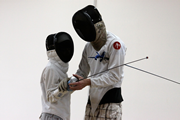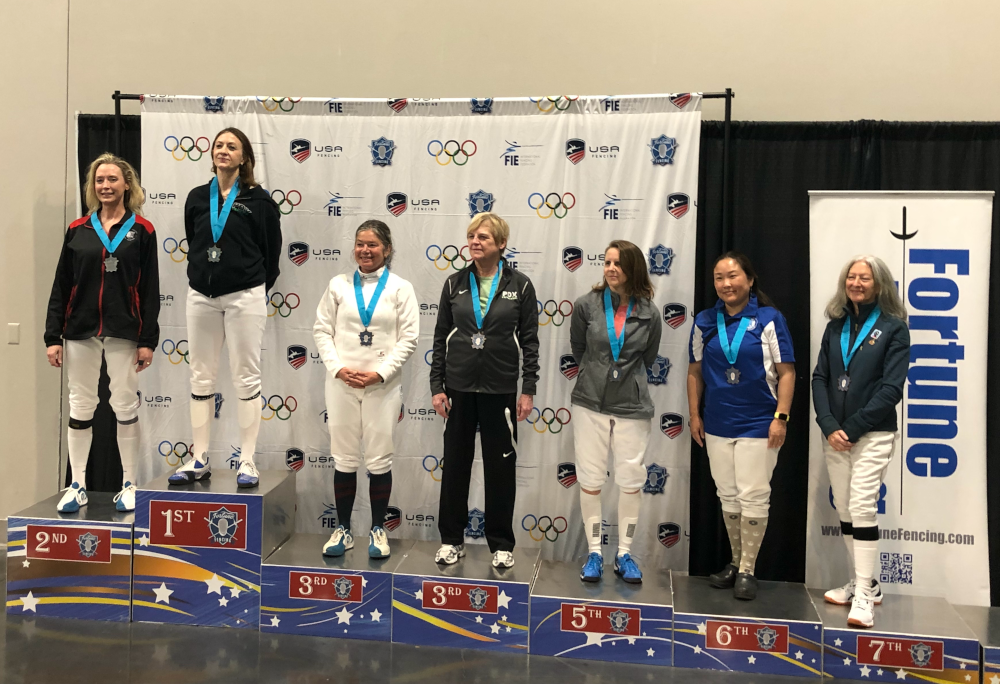

Presidio Fencing Club provides training and practice in Olympic sport fencing to novice and experienced athletes, aged 10 to Adult. We are a member club of the Southern California Division of the United States Fencing Association. We operate under the umbrella of the Central Coast Fencing Foundation, a 501(c)(3) non-profit organization (tax ID# 820540198).
For insurance purposes, membership with the United States Fencing Association is required before joining any class. After their 90-day, free trial membership, new fencers should opt for the "Access Membership," which is $29 and expires on July 31. Membership may be purchased by creating an account at USFencing.org.
We train as a team, twice per week. Practices include fencers with a range of abilities, from beginner to advanced, and sometimes even the elite/Olympic level. Practices are always confirmed on the club's Google Calendar.
Thursdays, 5:30 - 7:30 pm at the Veteran's Memorial Bldg on Cabrillo:
Sundays from 12:30 - 3:00 pm at the Goleta Valley Boys and Girls Club on Hollister:
Note that fencers must have their own gear to fully participate in group classes. See our equipment page for a list of what to buy. There may be some second-hand equipment available through our online swap meet.


Introductory classes are held on Sundays from 1 - 2 pm at the Goleta Boys and Girls Club. Coach Tim works with small groups of new fencers to teach the basic footwork and blade work technique needed for participation in the Thursday Drills and Sunday Sparring classes. While fencing is fun, it is also difficult to experience in just a single class or two. Please take advantage of USA Fencing's Trial Membership, which allows you to attend as many Introductory Classes as you like for 90 days. But please keep in mind there are some Sundays where we are unable to practice. Also, since we only provide a minimal amount of equipment, the curriculum remains basic.
Due to the range of ages and ability levels among club members, it is imperative that students be able to focus on the task at hand. Parents of younger athletes should contact us before showing up. Parents should also consider participating.
1. Complete the Registration Form using the button above and then check the club Google calendar for the next available Sunday class.
2. Register with USA Fencing for a free
trial membership. This free trial will be good for 90 days and will give you an opportunity to try out some basic classes.
3. Show up. Wear comfortable clothes and athletic shoes, and bring a water bottle. You might also want to bring a spare t-shirt. Presidio's classes impart basic technique through repetition. They're like fitness classes, but instead of an aerobics step or other equipment, you'll use a sword. Some practices may only involve practicing footwork, but you will eventually get the moves down and be ready to go toe to toe with an opponent.
4. Watch the preparatory and footwork videos linked below in our References section. Video Group #1 is a little dated, but the actions are sound. Video Group #2 is an innovative approach to fencing movements taught by Olympian Dave Littell. He provides a whole series of valuable videos that start with a functional understanding of the sport.
5. Try at least four introductory classes and, in between lessons, continue to practice the basic footwork and movements you learn. While there is a floor fee of $20/class ($105/7 classes) for Drill and Sparring sessions, we do not charge for Introductory Classes. We want you to spend that money on some gear. Of course, donations are always welcome.
6. When you're ready for group drills and sparring, purchase your equipment. Find a list of what to buy on our equipment page. A complete set of brand new gear will cost ~$300 (mask, jacket, glove, underarm protector, chest-plate, weapon, and body cord). Presidio Fencing Club is not an equipment vendor; however, we do try to connect new and old fencers to sell second-hand gear.
7. After 90 days you will need to purchase an Access Membership ($29) from US Fencing in order to continue. This fee is paid directly to US Fencing and provides access to regular club activities.
Fees and Services |
Payment via Cash, Check, or Venmo (@presidiofencing)
|
|
|
"Floor Fee" |
|
|
|
Private and Semi-Private Lessons |
|
|
|
Tournament Coaching |
|
|
|
Armoring and Equipment Maintenance |
|
|


Photo courtesy Doug Golupski